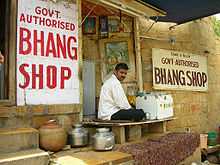Bhang
Bhang (Hindi: भाँग) is a preparation from the leaves and flowers (buds) of the female cannabis plant, consumed as a beverage in the Indian subcontinent.
Indian subcontinent
Bhang has been used as an intoxicant for centuries in the Indian subcontinent. Bhang in India and Nepal is distributed during some Hindu festivals like Holi, and consuming bhang at such occasions is a common practice.[1][2]
History
Bhang has been used in India since Vedic times, and is an integral part of North Indian culture. Sadhus and Sufis use bhang to boost meditation and to achieve transcendental states. Bhang or cannabis is also used amongst Sufis as an aid to spiritual ecstasy.
In 1596, Dutchman Jan Huyghen van Linschoten spent three pages on "Bangue" in his historic work documenting his journeys in the East, also mentioning the Egyptian Hashish, Turkish Boza, Turkish Bernavi, and Arabic Bursj forms of consumption.[3]
The historian Richard Davenport-Hines lists Thomas Bowrey as the first Westerner to document the use of bhang.[4]
Preparation
Anywhere on the ghats, one can find large number of men engaged in the process of preparing bhang. Using mortar and pestle, the buds and leaves of cannabis are ground into a paste. To this mixture, milk, ghee and spices are added. The bhang base is now ready to be made into a heavy drink, thandai, an alternative to alcohol; this is often referred to casually, if inaccurately, as a "bhang thandai" and "bhang lassi". Bhang is also mixed with ghee and sugar to make a purple halva, and into peppery, chewy little balls called 'golee' (which in this context means candy or pill in Hindi).[5]
Culture
Bhang has become an integral part of tradition and custom in the Indian subcontinent.
In some sections of rural India, people attribute various medicinal properties to the cannabis plant. If taken in proper quantity, bhang is believed to cure fever, dysentery, sunstroke, to clear phlegm, aid in digestion, appetite, cure speech imperfections and lisping, and give alertness to the body.[6]
See also
- Charas
- Holi
- Kief
- Legality of cannabis by country
- List of Indian beverages
- Spiritual use of cannabis
References
- ↑ "Right kick for day-long masti". Times of India. Retrieved 17 March 2014.
- ↑ "Holi 2014: Festival Of Colors Celebrates Spring (SONGS, PHOTOS)". Huffington Post. Retrieved 17 March 2014.
- ↑ Burnell, Arthur Coke & Tiele, P.A (1885). The voyage of John Huyghen van Linschoten to the East Indies. from the old English translation of 1598: the first book, containing his description of the East. London: The Hakluyt Society. p. 115-117. Full text at Internet Archive. Chapter on Bangue.
- ↑ Davenport-Hines, Richard (2001). The pursuit of oblivion: A global history of narcotics 1500—2000. London: Weidenfeld & Nicolson. pp. 1–2. ISBN 0297643754.
- ↑ http://www.originalweedrecipes.com/indian-bhang/
- ↑ Holi Festival Tradition of Bhang
External links
- Tradition of Bhang in Holi
- Weed Milk Recipe, from theCannabisChef.com
- Bhang Ganja Charas, Thandai Chai Lassi, IndiaCurry.com
- "A Bit about Bhang"
- Recipe: Bhang Lassi
- Hot-Buttered Bhang Recipe
- "A Word from the Indian Hemp Drugs Commission" A 19th century British report on Bhang
- Special Featured Article on Bhang
- "Recipe for Bhang-Elixir of life"
- Bhang news page - Alcohol and Drugs History Society
| ||||||||||||||||||||||||||||||||||||||||||||||||||||||||||||||||||||||||||||||||||||||||||||

